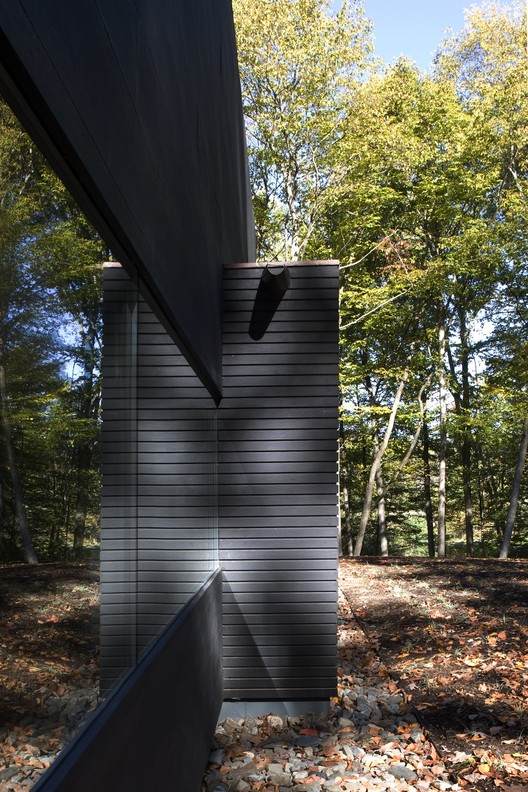
Architects: Cooper Joseph Studio Location: Dean Road Ghent, NY, USA Architect In Charge: Wendy Evans Joseph Project Manager: Thruston Pettus Desing Team: Farzana Gandhi, Jonathan Lee Project Year: 2007 Photographs: Elliott Kaufman
Project Area: 525.0 sq ft Landscape Architect: Peter Rolland Landscape Contractor: Rusty Dunbar
The writer’s studio is a place for one person to work, read and listen to music. Open vistas to a pond and fields are to one side, the other side is immersed in deep woods. The overall impression of the structure is deceivingly simple. Each façade is composed with distinct apertures specifically arranged to the light, the views and tailored, like a bespoke suit to his size and eye level. The inside is, uncluttered and elegant, unified by the use of walnut.
Design solution

Minimalist detailing, open glazed corners and transparency running the length of the structure challenge the simplicity of the “box”. Given harsh winters, the fireplace becomes the visual center, anchoring the asymmetrical composition with large, richly conceived hearth. On a structural level, the fireplace also anchors the large cantilevered corners to either side. The studio volume is a small, rectilinear and restrained single-room space in the woods. The entire interior is immersed in walnut in varied ways. The rigid orthogonal geometry of the room is juxtaposed with dynamic sculptural designs of the furniture – a desk, a side table and two black leather armchairs.
The sliding doors are walnut plank, the pantry counter is walnut, the floors are highly polished walnut, the sink in the bathroom is made of walnut as well as some of the wainscoting in the main room. On the outside, cedar received a matte black stain, the same surface treatment for the flat broader, horizontal boards and the highly textured, thinner slats. Each was a precisely laid and mitered at the corner. Copper trim and scuppers set off the forms. The choice of using only wood framing was pragmatic, but it worked very well for even the large cantilevered roof sections over corner glass-to-glass windows at the north side of the building.
Energy and sustainability

Our strategy involves efficient equipment, passive heating and cooling, locally available materials and a wood-burning fireplace that uses wood fuel from trees on the property. The stone is black slate. By locating the house in the deep deciduous woods, we are able to take advantage of the leaves as sun shading in the summer months. In the winter, when the trees lose their leaves, the building’s black exterior absorbs sunlight and with the fireplace, there is a reduction in fuel consumption.
Interior finishes:

The interior walls are a composition of walnut slats and white surfaces. A bookshelf, the kitchen and the window seat are all entirely of solid walnut allowing for uniformity of texture and color. The sliding door to the kitchen is walnut as well. As sunlight is filtered through the trees, the floor becomes a key surface, reflecting natural light with a warm hue. It’s high polish balances nicely with the lower intensity sheen on the walls and horizontal surfaces. The fireplace has a river stone surround (to code) set flush to the wood slats. Next to it is the wood storage area. The wood enters this alcove from behind, as there is a hidden door in the north façade of the building allowing the fire to be easily maintained without having to bring the wood through the front door.
Bathroom:

With a shower wall entirely in glass and a ceiling-mounted “rain” fixture, it feels like being outdoors. Its drains are all hidden so that there is virtually no reading of the shower except when in use. The same slats continue in the bathroom on the entire entry wall and elsewhere above the local black slate. We designed the bathroom sink in walnut as well. Here we used solid stock with channels cut to carry the water to a trench drain cut into the wall. The channels are sloped. They are closer together near the faucet and further apart to the edges there providing more surface for a cake of soap or glass.
Furniture:

As there are very few objects within the space, it was critical that their design and materiality work well with the minimal interior finishes. Again, for the desk and table we turned to walnut for its warmth, strength and texture. The desk is located on axis with a fireplace with views around it north to a pond and fields beyond, but it has an asymmetric relationship to the elements of the room. Technically, it was an achievement to make a large, heavy, wood top cantilever and its sculptural form makes this possible. In this way, when you enter the room, there is no visible structure and the plane of the surface floats freely. Below, on the backside there is a shelf (with hidden pencil drawer) for the printer.
The electric connection is under the open base, and only a small slot for the cord disturbs the desk surface. The “scholar stone” sits above this slot. The magazine table echoes the form of the desk nearby but with a ribbed construction that relates to the slatted walls in the room. Once more, the triangulated geometry sets it apart from the architecture. Each rib differs in configuration from its neighbor so that viewed in one direction it emphasizes the angular surfaces and from the other the surfaces blend to appear as solid planes. It’s a bit of an optical illusion due to the precise geometry. The form holds the books or newspaper on the open shelf against the lounge chair so that the room still appears free of clutter.















